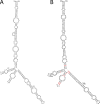Discovery of a Novel Hepatovirus (Phopivirus of Seals) Related to Human Hepatitis A Virus
- PMID: 26307166
- PMCID: PMC4550696
- DOI: 10.1128/mBio.01180-15
Discovery of a Novel Hepatovirus (Phopivirus of Seals) Related to Human Hepatitis A Virus
Abstract
Describing the viral diversity of wildlife can provide interesting and useful insights into the natural history of established human pathogens. In this study, we describe a previously unknown picornavirus in harbor seals (tentatively named phopivirus) that is related to human hepatitis A virus (HAV). We show that phopivirus shares several genetic and phenotypic characteristics with HAV, including phylogenetic relatedness across the genome, a specific and seemingly quiescent tropism for hepatocytes, structural conservation in a key functional region of the type III internal ribosomal entry site (IRES), and a codon usage bias consistent with that of HAV.
Importance: Hepatitis A virus (HAV) is an important viral hepatitis in humans because of the substantial number of cases each year in regions with low socioeconomic status. The origin of HAV is unknown, and no nonprimate HAV-like viruses have been described. Here, we describe the discovery of an HAV-like virus in seals. This finding suggests that the diversity and evolutionary history of these viruses might be far greater than previously thought and may provide insight into the origin and pathogenicity of HAV.
Copyright © 2015 Anthony et al.
Figures





References
-
- Anthony SJ, St Leger JA, Pugliares K, Ip HS, Chan JM, Carpenter ZW, Navarrete-Macias I, Sanchez-Leon M, Saliki JT, Pedersen J, Karesh W, Daszak P, Rabadan R, Rowles T, Lipkin WI. 2012. Emergence of fatal avian influenza in New England harbor seals. mBio 3(4):e00166-12. doi:10.1128/mBio.00166-12. - DOI - PMC - PubMed

